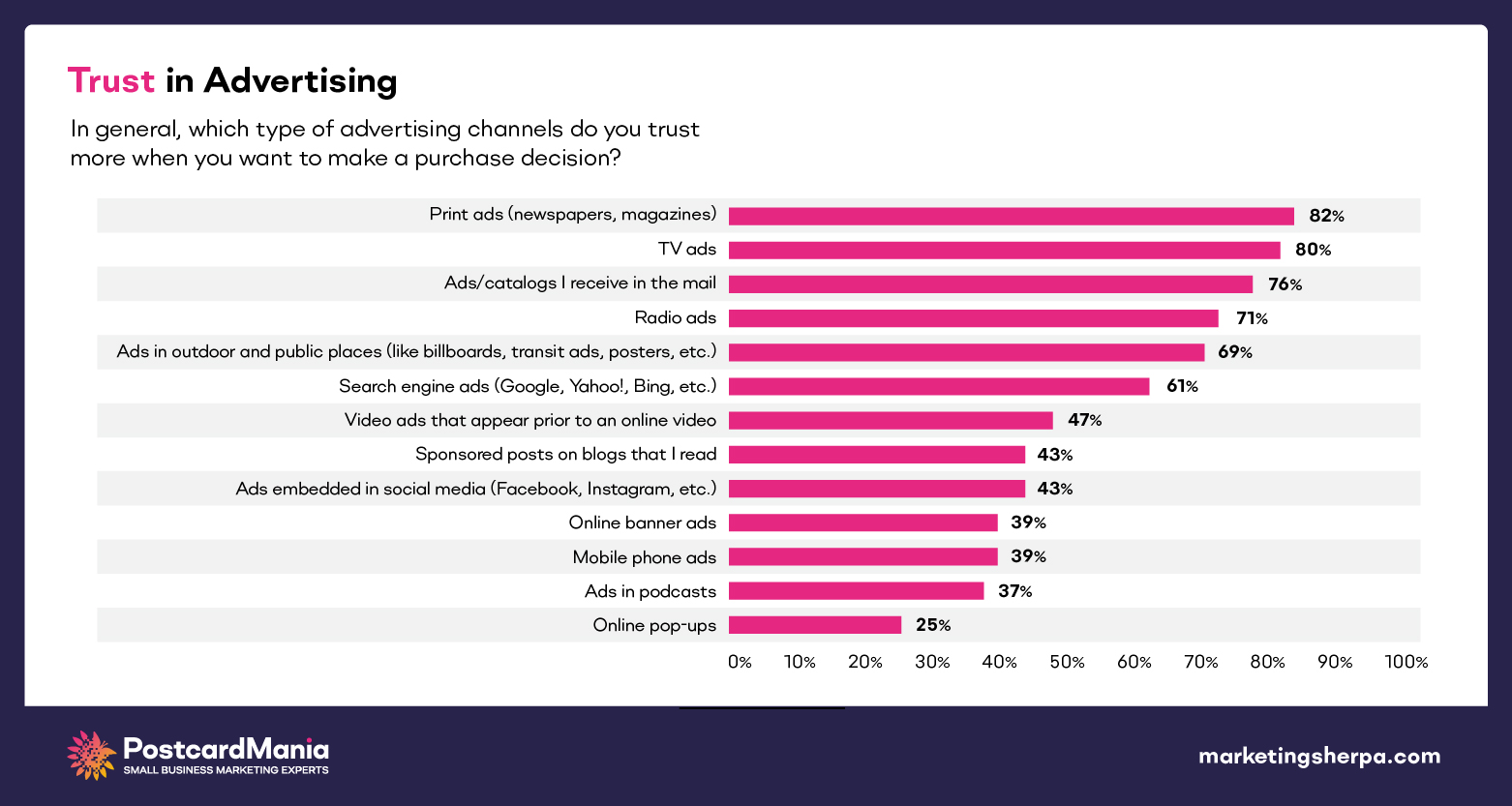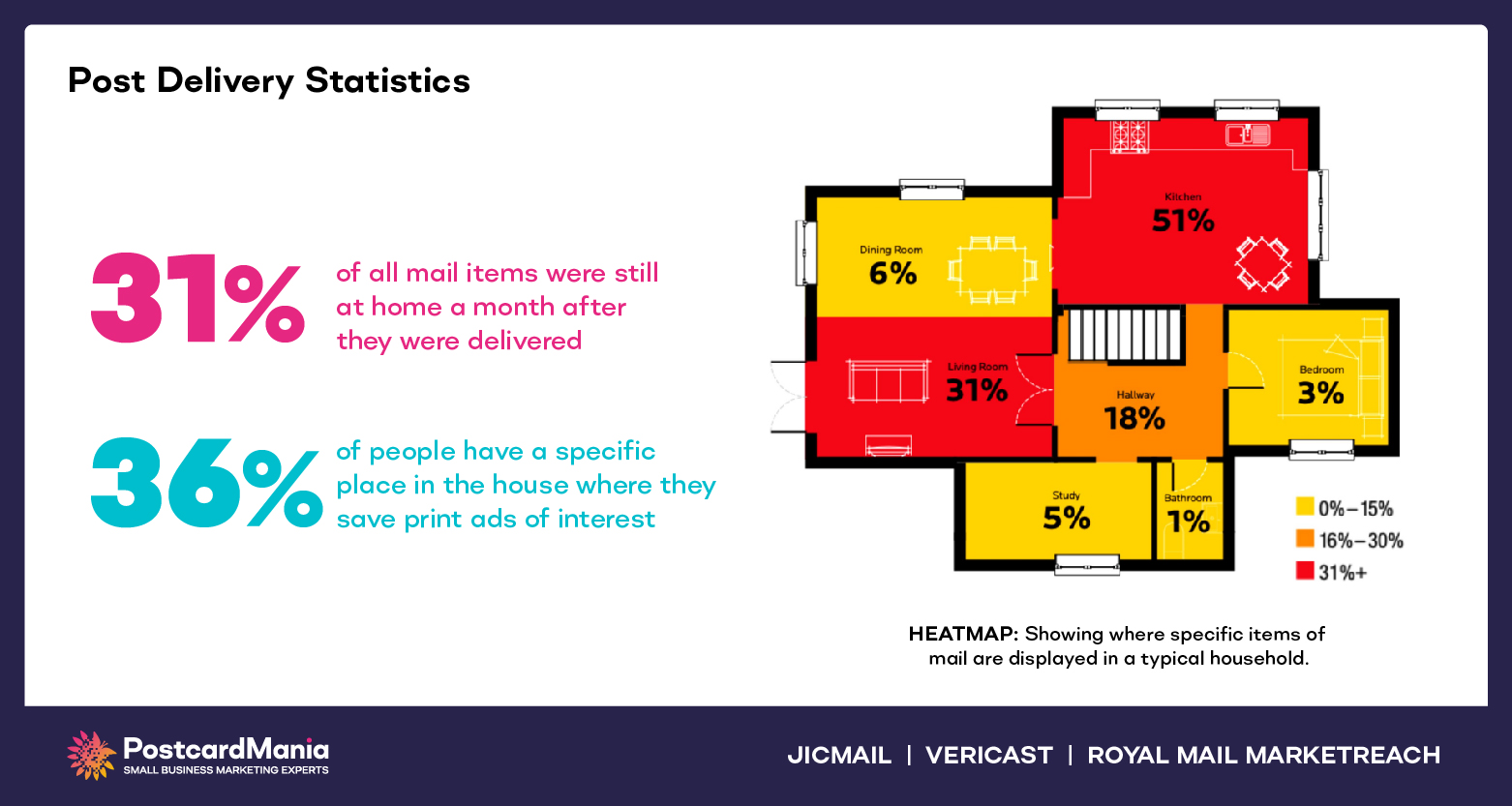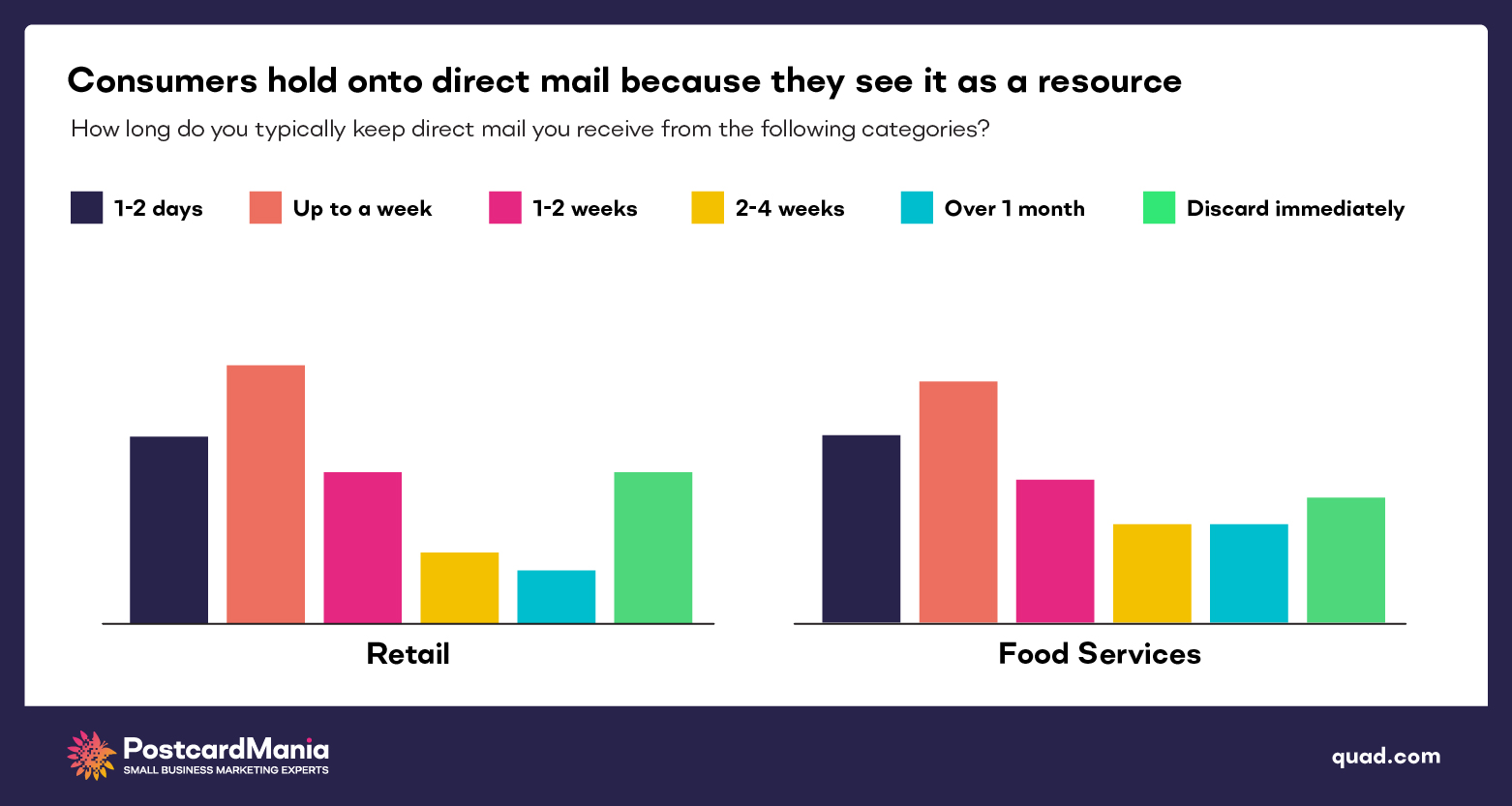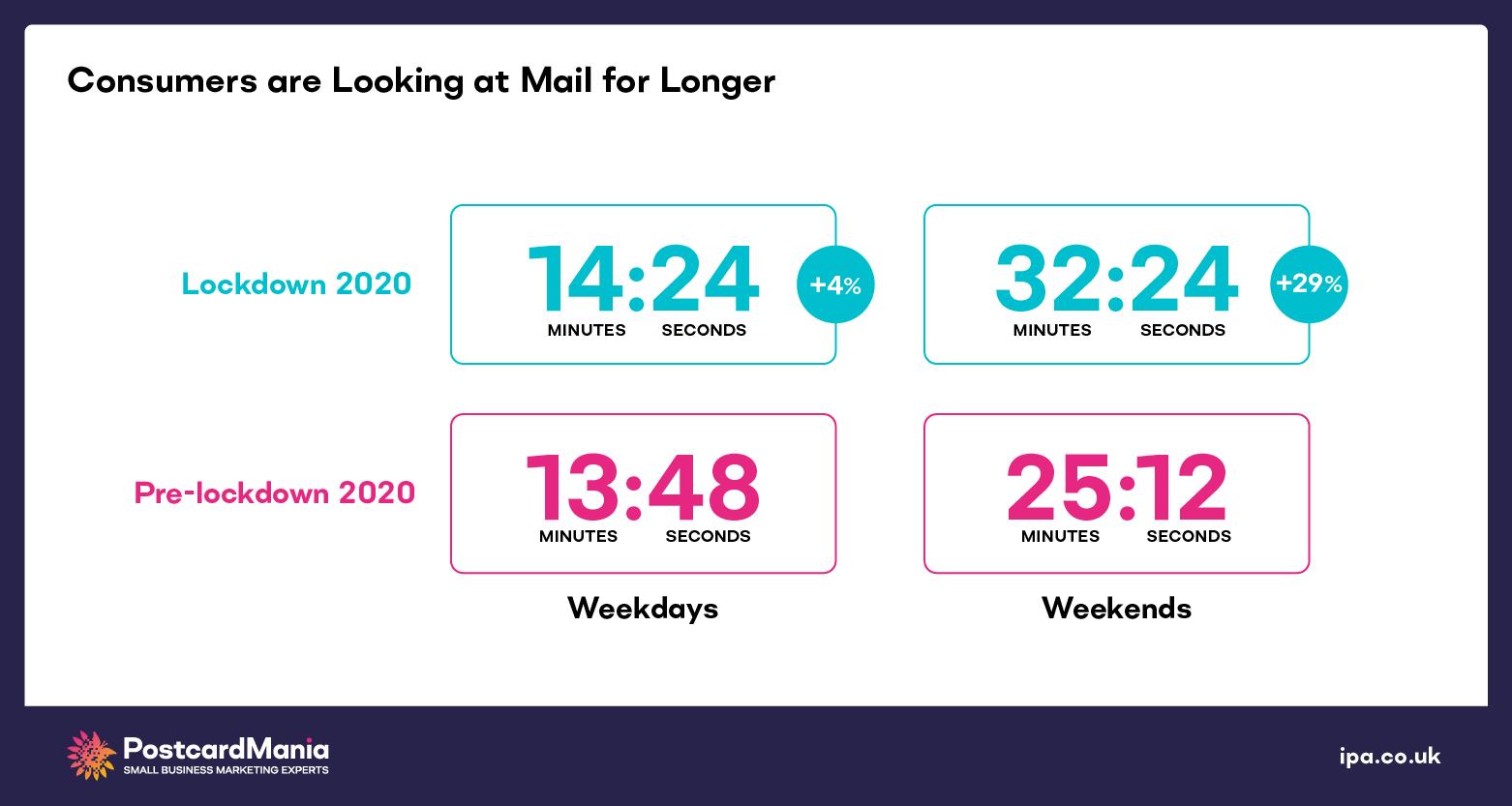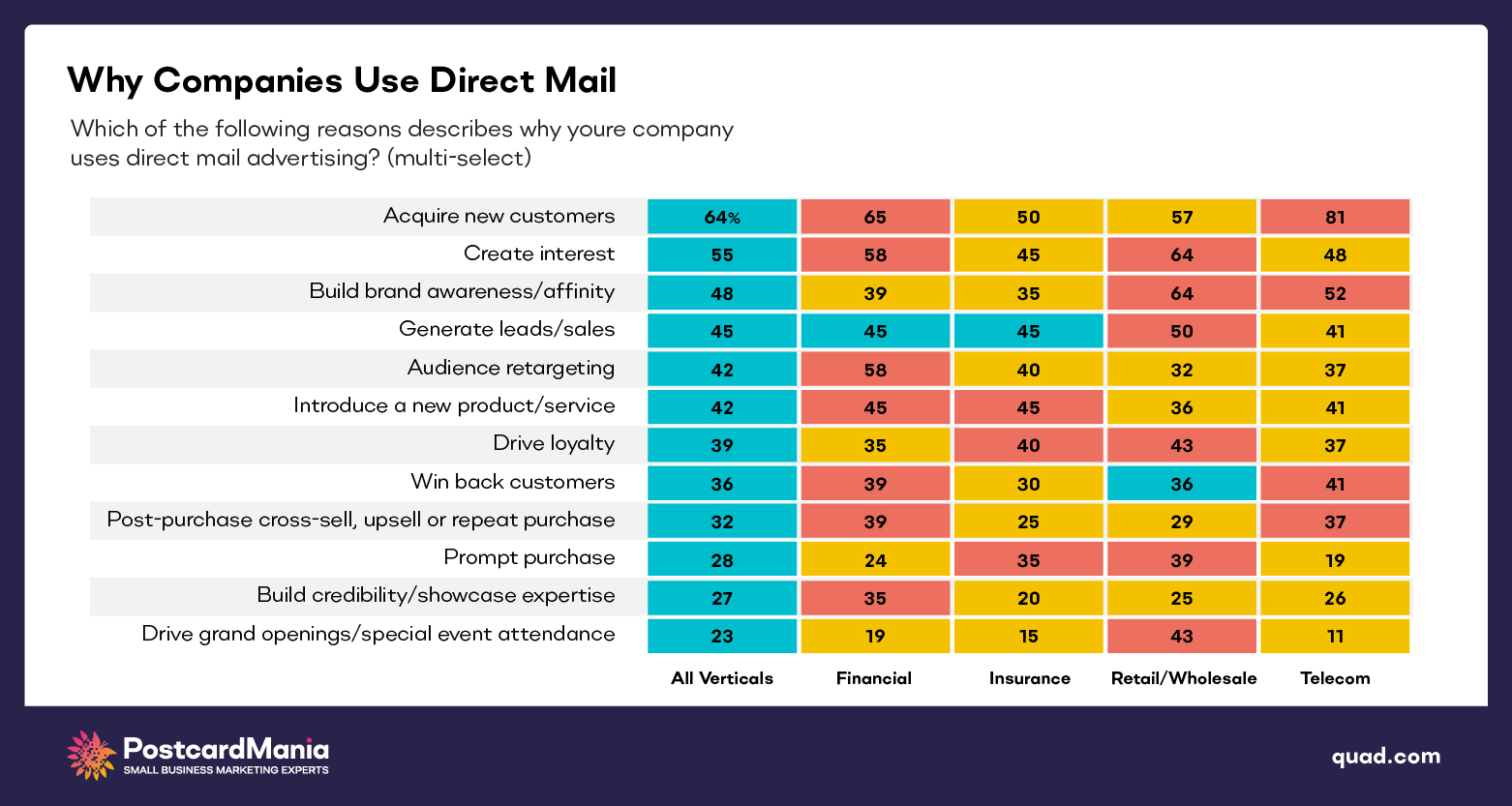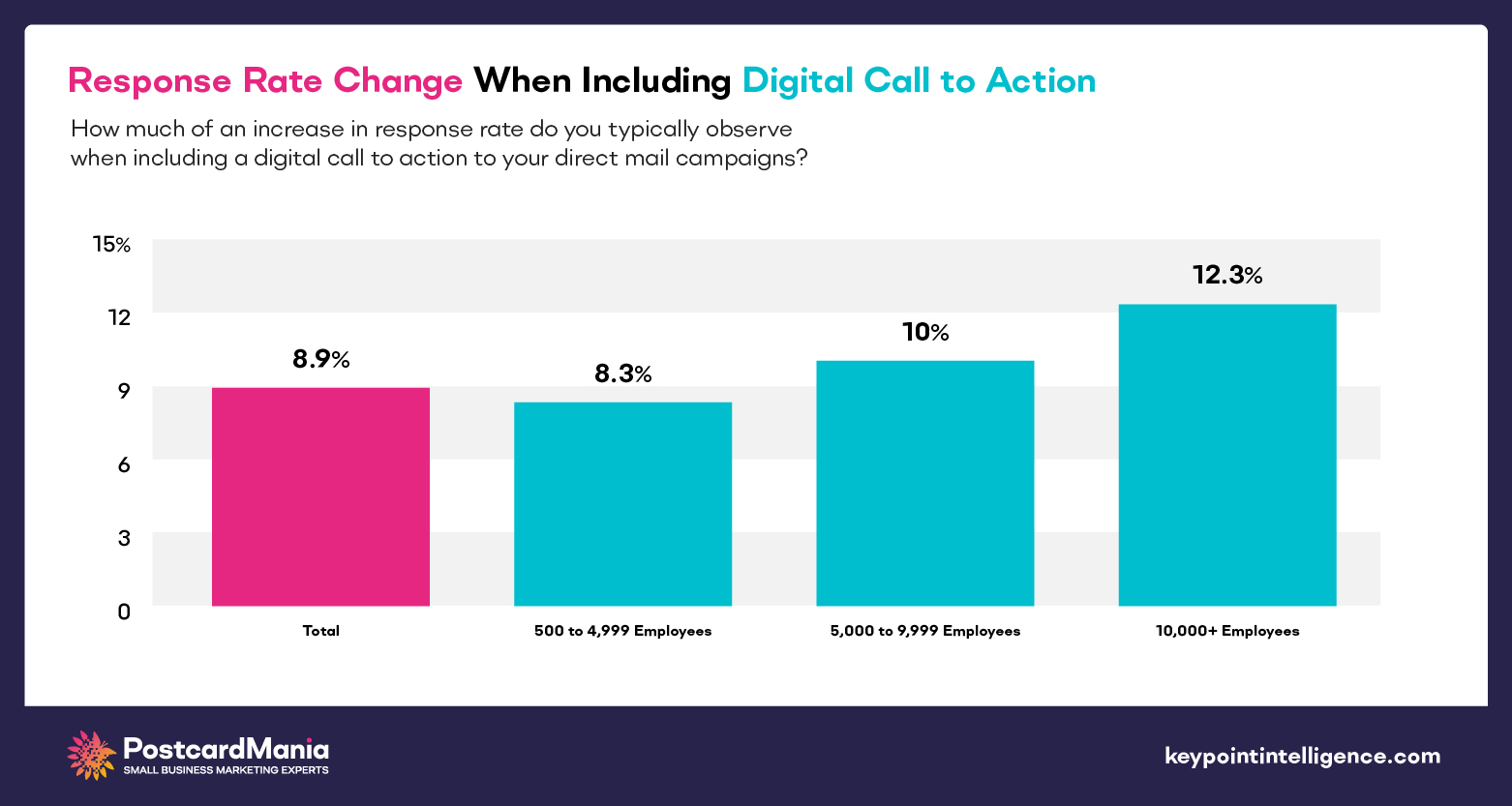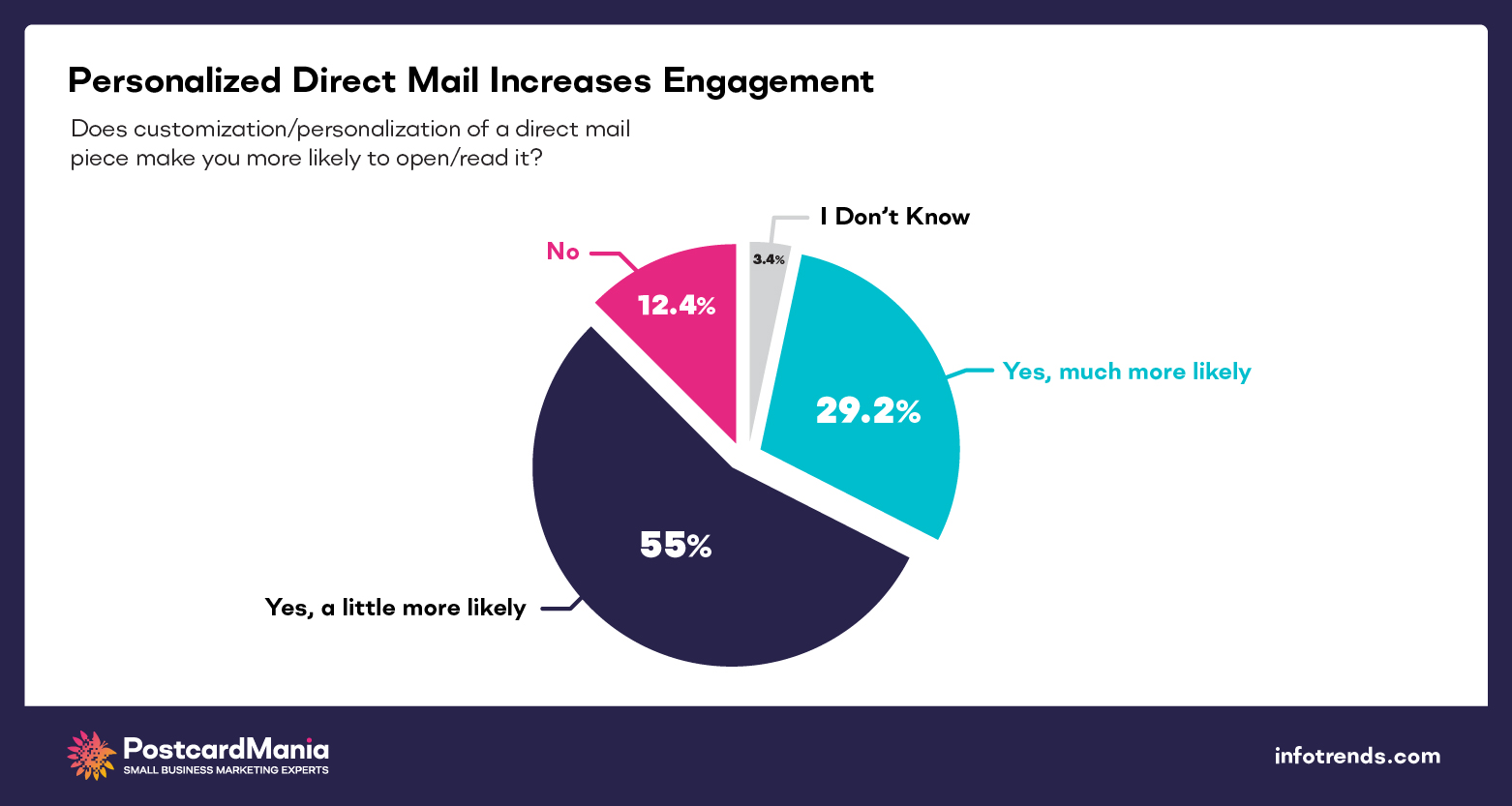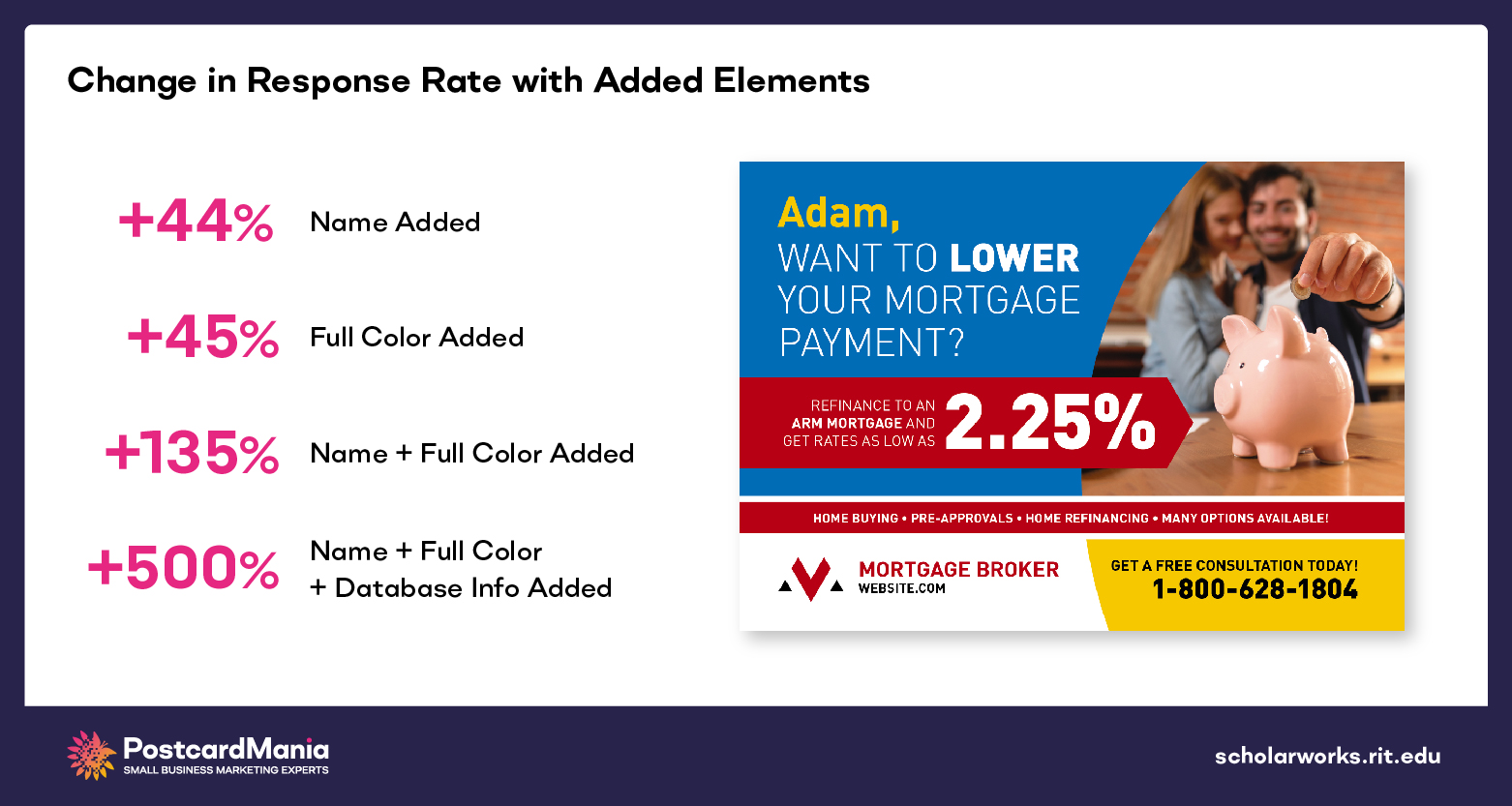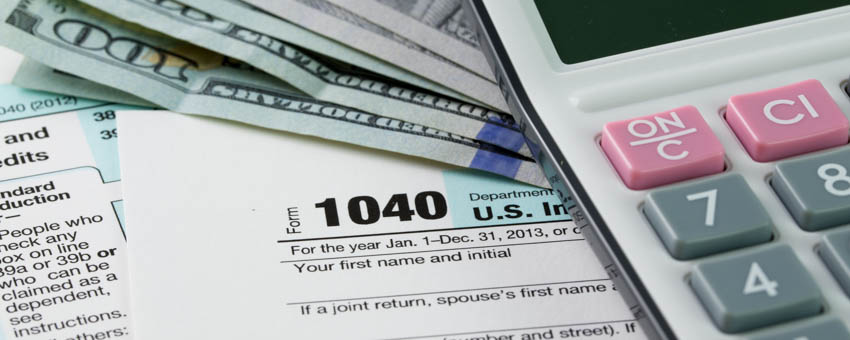166 Direct Mail Statistics You Should Know in 2024
Updated on May 1, 2024What is your impression of direct mail? Most people view it as a bit old school, and while it’s true brochures, flyers, postcards, letters, and the like are the oldest forms of advertising, they aren’t obsolete.
We live in a digital world, but you might be surprised to know that some of the biggest companies in the United States still rely on direct mail to stay connected with their customers, increase leads and increase sales.
For example:
Even Google sends direct mail to bring in new business.
We’ve collected the latest studies and statistics on direct mail to not only prove print is not dead — but thriving. If you need to move the needle on your business’s goals, direct mail marketing is your next best marketing strategy.
You might be shocked by what the data reveals!
Looking for specific direct mail stats? Jump right to the section you want:
PostcardMania’s Direct Mail Statistics
Direct Mail & Gen Z, Millennials, Gen X, and Baby Boomers
Direct Mail Return on Investment (ROI)
Direct Mail Sentiment: How consumers feel about direct mail
The Science Behind Direct Mail’s Effectiveness
Direct Mail Adoption: How businesses large and small use direct mail
Direct Mail and Digital Integration
Direct Mail Automation and Retargeting: How new technologies are changing mailers
Taking Action: How to get started with direct mail marketing
PostcardMania’s Direct Mail Statistics
So, who are we exactly? You can always read more about us here, but the short version is that we’re an $97 million marketing company with 117,871 clients specializing in direct mail-led campaigns. That means we have a lot of direct mail experience to share. Below you’ll find key industry insights and trends based on our own unique data that you won’t find anywhere else.
- More businesses are choosing direct mail. Between 2010 and 2019 (over 9 years), PostcardMania’s average weekly mail volume increased 104%. In 3 short years, (between 2019 and 2022) average weekly mail volume increased 39%.
- Businesses are also mailing more. In 2022, PostcardMania’s average weekly mail volume increased by 220,300 pieces per week, an 8.15% increase.
- Direct mail is growing faster post-pandemic. From 2020 to 2023, PostcardMania’s annual revenue has grown an average of 15% each year. In the decade previous (2009–2019), annual revenue growth averaged only 4.67%.
- The turnaround time for direct mail — from order date to delivery — is faster than ever. As of August 2023, PostcardMania has reduced average design approval time and mail delivery time by 12% and 13% respectively from 2021 to 2023 year to date. In a sign of gaining momentum, July 2023 set a new record for fastest delivery turnaround time — 33% faster than 2021’s average.
- New direct mail technologies are growing fast. Our fastest-growing services and products fall under PCM Integrations, a newly formed division that oversees technology-driven partnerships and direct mail automation. PCM Integrations’ revenue grew 154% in 2021, 38% in 2022, and 45% in 2023. More recently, the third quarter of 2023 marked an all-time quarterly record as revenue for our most tech-centered services increased more than 24% quarter over quarter and nearly 71% over the same quarter last year.
- Direct mail leads generate 600% more revenue than digital leads. We analyzed 114,373 leads that converted to sales in 2023. Findings: Postcard leads generated 6x more revenue per lead than leads from digital sources.

- Digital ad prices increased more than tenfold compared to direct mail. Facebook reported that their average price per ad increased 24% in 2021 over the previous year. By comparison, the average price to mail a single postcard only increased 1.57%. That’s a 14-fold difference.
- More businesses are choosing PostcardMania for direct mail. Annual revenue grew roughly 15% year over year in 2022 and 8% in 2023, up to $104.6 million. On average, we mailed 5 postcards every second on behalf of American businesses in 2023.

- Direct mail growth accelerated at the end of 2022. PostcardMania set new revenue records for its highest-ever revenue month and quarter in December and Q4 2022 respectively.
- In May 2022, PostcardMania hit a single-week, highest-ever in sales at $2.64 million, 53.28% higher than our previous record of $1.72 million set in November of 2020.
We pride ourselves on results-based campaigns that help small business owners eliminate the oftentimes costly process of marketing trial and error.
We’ve published more than 700 case studies about successful direct mail campaigns for over 50 different industries, offer free samples and design templates, and provide free marketing advice regardless of whether a business ever chooses to work with us or not.
Both younger and older demographics view direct mail as valuable.
You’d think that Millennials and Gen Z would prefer digital media over printed advertisements, but the data surprisingly reveals this is not the case! Both older and younger groups responded overwhelmingly well to direct mail and said it influenced their buying behavior.
GENERATION Z (born between 1997 and 2012):
- Younger generations are the most enthusiastic about the usefulness of direct marketing — 57% of 18- to 34-year-olds said they found direct mail extremely or very useful, higher than any other age group. This figure rises to 85% for those who find it somewhat useful. The Direct Marketing Revolution Report (2023)
- 63% of Gen Z consumers are more excited about direct mail now than they were a year ago. RRD (2023)
- Direct mail particularly resonates with Gen Z because they have grown up with digital messaging, and mail presents something unique to them. MarketReach (2021)
- 72% said they would be disappointed to no longer receive mail and say they are excited to discover what the mail brings every day. USPS (2021)
- The response rate for direct mail among people ages 18-21 is 12.4% compared to a .12% response rate for digital ads. The Data & Marketing Association (2018)

MILLENNIALS (AKA Generation Y, born between 1981 and 1996):
- Among 35- to 49-year-olds, 88% reported that direct mail was extremely/ very/somewhat useful. The Direct Marketing Revolution Report (2023)
- 62% of Millennial consumers are more excited about direct mail now than they were a year ago. RRD (2023)
- Millennials have the best perception of retargeted direct mail, and 64% said they would be likely to read it. USPS (2021)
- 47% of Millennials went to a brand’s website after receiving direct mail, which was the highest percentage of all age groups. USPS (2021)
- 82% of Millennials view print advertisements as more trustworthy than digital ads. USPS (2019)
- 62% of Millennials say they tend to read advertising mail they receive, rather than discard it without reading, whereas 33% said they use online ad blockers. USPS (2019)

- 62% of Millennials said they had visited a store in the past month based on information received in the mail—more often than Gen-Xers or Boomers. USPS (2019)
- 75% of Millennials said receiving personal mail makes them feel special. USPS (2019)
- 66% of Millennials bring marketing mail into retail stores. USPS (2019)
- 67% of Millennials use marketing mail as a prompt to go online. USPS (2019)
- 49% of Millennials prefer to shop at stores that advertise to them through the mail. USPS (2019)
- 40% of millennials regularly purchase items featured in marketing mail. USPS (2019)

- When asked which form of marketing encourages people to take action, 30% of millennials went with direct mail and 24% went with email, even about the unwelcomed offers of companies. InfoTrends (2016)
GENERATION X (born between 1965 and 1980
- 68% of Gen-Xers used coupons they received in the mail. Vericast Consumer Intel Report (2021)
- 70% of Gen-Xers are excited to discover what the mail brings every day. USPS (2021)
- According to the Pew Research Center, Generation X is projected to outnumber Boomers in 2028. Since they are the “middle child” of generations, they are not only purchasing items for themselves but also their parents and kids. Hence, direct mail has a potentially larger impact on their spending. Pew Research Center (2020)
- According to Creative Director of Polaris Direct Amber Jodoin, Generation X is unique in that it played a critical role in emerging technologies, yet remembers the world prior to the digital revolution. As such, this generation is digitally savvy, yet also continues to appreciate traditional media, like direct mail. Polaris Direct (2019)
- 60% of Gen-Xers pick up the mail at least 6 days a week in comparison to 44% of Millennials. USPS (2018)
- Generation X is more brand-loyal. 50% said they are extremely loyal whereas 14.6% said they are willing to try new brands, and over 80% said they like joining loyalty programs and receiving discounts from their favorite brands. CrowdTwist (2015)

BABY BOOMERS (born between 1946 and 1964)
- More than any other generation, Boomers prefer to read promotional deals and communications via direct mail rather than digital forms like email. 50% said they preferred direct mail. USPS (2021)
- 2/3 of Boomers have a better impression of a brand that sends out direct mail, and 1/3 of Boomers visited a brand’s website after receiving relevant marketing mail. USPS (2021)
- 89% of Boomers expect and look for special offers in the mail; coupons/deals are the most effective element for them on direct mail pieces. USPS (2021)
- Boomers felt catalogs, advertising cards, or flyers in the mail influenced their purchasing decision the most over ads on social networking platforms, email, or TV ads. Online video ads ranked among the lowest at 3%, while direct mail and recommendations from family and friends were among the highest at 30% and 28% respectively. Marketing Charts (2015)
- Americans 65 and older are more likely to enjoy checking their mail, ranking the highest at 65%. Gallup (2015)

Direct mail has a higher response rate than other forms of advertising.
Did you know the USPS reports the average household receives 7,750% more emails than mail pieces per day — an average of 2 direct mail advertisements as opposed to 157 emails a day? In today’s digital landscape, more people are becoming overwhelmed by the massive influx of digital ads and are ignoring them more often. The stats show people are now more receptive to receiving direct mail marketing than ever before.
- 36% of people have a specific place in the house where they save print ads of interest. Vericast (2024)
- 74% of marketers agree direct mail delivers the best conversion rate of all the channels their company uses today. The State of Direct Mail (2023)
- Actions consumers have taken as a result of receiving direct mail: 57% visited the brand’s website, 53% searched for that brand online, 46% searched for online reviews, 38% visited a retail location, 36% made a purchase, 28% visited another website, 20% checked that brand’s social media. The State of Direct Mail (2023)

- 80% of consumers who scanned a direct mail Flowcode (aka QR codes that can be edited even after being printed) in one retail campaign volunteered their email addresses. The Direct Marketing Revolution Report (2023)
- 70% of marketers say their direct mail performance has improved in the last 12 months, an increase of 5% over 2022. Only 2% say performance declined, with the rest saying it stayed the same. Direct Mail Industry Report 2023 (2023)
- The average piece of business mail is interacted with for 150 seconds on average across a 28 day period; direct mail for 108 seconds; partially addressed mail for 64 seconds and door drops for 46 seconds. Interestingly, people consistently self-reported spending more time with mail than was observed during research. JICMAIL Attention Study (2023)
- Direct mail that prompts a commercially beneficial outcome for a brand typically generates attention 2–3X times higher than average. JICMAIL Attention Study (2023)
- Direct mail evokes more time and attention on other channels. When prompted by direct mail, people on average spent: 5:33 online, 4:53 making a call, 1:36 using a smart phone, 0:33 writing an email, 0:29 talking about it, and 0:06 tearing off a voucher. JICMAIL Attention Study (2023)
- Some commercial actions don’t need long to take effect. It only takes 6 seconds to tear off a voucher from a mail item, but over a fifth of respondents had used vouchers in the last few weeks. JICMAIL Attention Study (2023)

- 81% of marketers who use a software platform for direct mail agree it delivers the best response rate their company uses today. This shifts to 70% for respondents who do not use a software platform. The State of Direct Mail (2023)
- 78% of B2B marketers agree their analog touchpoints (e.g., direct mail) have been performing better than they had a year ago. Forrester Opportunity Snapshot (2022)
- Marketers report better response rates — a lift of 18% — when direct mail is included in the multichannel mix. Demand Metric (2020)
- Direct mail has an average engagement rate of 95% and is interacted with at least 4 times at home. MarketReach (2021)
- Direct mail case studies grouped by WARC showed 70% of people were driven toward an online activity by direct mail, and 35% of consumers made a purchase as a result of direct mail. MarketReach (2021)
- Direct mail is read more often than email among all age groups, and 71% of all consumers are excited to discover what the mail brings every day. USPS (2021)
- A record 96% of all mail was engaged with. This is an increase from 2019 which was at 91%. JICMAIL (2020)
- 75% of business mail stays in the home for over four weeks and is revisited an average of 5 times. MarketReach (2020)
- Direct mail response rates are 5 to 9 times higher than any other advertising channel. The Data & Marketing Association (2018)
- 39% of consumers try a business for the first time because of direct mail. The Data & Marketing Association (2018)
- In 2018, the average American household received 454 pieces of mail. The study revealed that 57% of consumers opened addressed mail envelopes, 48.5% looked at what it is, 24.5% kept it to read later, and 1.6% of the recipients put them in the open for display. USPS (2018)
 Direct mail’s average response rate increased from 2.9% to 4.9% for prospects lists and 5.1% to 9% for house lists (current customers/database) between 2017 and 2018. The Data & Marketing Association (2018)
Direct mail’s average response rate increased from 2.9% to 4.9% for prospects lists and 5.1% to 9% for house lists (current customers/database) between 2017 and 2018. The Data & Marketing Association (2018)- 90% of mail is opened by recipients, while only 20–30% of emails are opened/seen. DMA (2018)
- Postcards have the highest response rate (4.25%) among different types of direct mail, such as dimensional mailers (4%), catalogs (3.5%) and letter-sized envelopes (3.5%). DMA (2018)
- When compared to email, paid search, and social media, household mail has a higher response rate at 9%, with the former being only at 1%. The Data & Marketing Association (2018)
- A whopping 31% of all mail items were still at home a month after they were delivered. JICMAIL (2018)
- One study asked 1,200 consumers which advertising channels they trusted more. 76% of the group said they trust direct mail (postcards, catalogs, etc.), which is just 6% less than the leading group that trusted ads in newspapers and magazines. Marketing Sherpa (2017)

- 42% of recipients read or scan the direct mail they receive. The Data & Marketing Association (2016)
- 56% of consumers who responded to direct mail went online or visited a physical store. InfoTrends (2015)
- 62% of consumers who responded to direct mail made a purchase. InfoTrends (2015)
- 66% of direct mail is opened, and 82% of direct mail is read for a minute or more. InfoTrends (2015)
- 33.3% of people in one particular study said they were more likely to read direct mail than open and read emails, while 22.9% said they leaned toward reading emails. InfoTrends (2015)
- Mail boasts a stickiness in the home you won’t find with email or digital. Most mail (51%) is read and displayed in the kitchen, while nearly a third of mail (31%) can be found in the living room. This likely engenders repeat exposure and deeper brand recall. MarketReach (2014)

Direct mail has a higher return on investment.
People may report they like receiving direct mail more than emails, but does direct mail move the needle on conversions? The data shows direct mail has a significant influence on how much profit businesses generate, and the return on investment is well worth the time and effort.
- 74% of marketers agree that direct mail delivers the best ROI, response rate and conversion rates of all channels. Comperemedia (2023)
- 74% of marketers said direct mail delivered the best ROI of the channels their companies used. The Direct Marketing Revolution Report (2023)
- 74% of marketers— up from 67% in 2021 — agree that direct mail delivers the best ROI, response rate, and conversion rates than all other channels used. They also agree direct mail is a more effective channel for their company than email. The State of Direct Mail (2023)
- Marketers report better ROI — a lift of 12% — when direct mail is included in the multichannel mix. Demand Metric (2020)
- In one PostcardMania case study, a dermatologist mailed 12,000 postcards to residences in their local area and made $22,500 in profit, more than doubling their ROI of 239%. PostcardMania (2022)
- Respondents reported an 18% greater ROI when marketing campaigns incorporated direct mail. Marketing Charts (2020)
- 25% of people bought something as a result of receiving mail in the past 12 months. Royal Mail MarketReach (2020)
- 4 out of 10 people (40%) responded to direct mail and donated online. Dunham + Company (2020)
- 65% of households with incomes of $100k or more said they made a purchase in the past 30 days because of direct mail advertising. Valassis (2020)
- Direct mail recipients purchased 28% more items and spent 28% more money than people who didn’t get the piece of direct mail. USPS (2018)
- A third of mail pieces led to some kind of commercial action, and a third of them were shared with other people. JICMAIL (2018)
- A Brand Science review of multi-channel campaigns concluded that when mail was included in the marketing mix, campaigns had a 12% bigger ROI than those without mail. Royal Mail (2017)
- Direct mail generates 10% more customers than email (34% direct mail, 24% email). Direct Marketing Association (2016)
- 62% of consumers who responded to direct mail in the past 3 months made a purchase. InfoTrends (2016)
The majority of people view direct mail in a positive light, as opposed to other forms of marketing.
So how do people really feel about direct mail? Most people say they like it! These statistics report consumers’ reactions to advertisements in their mailbox, which are mostly positive.
- 49% of Americans of all ages look forward to checking their mail each day. Vericast (2024)
- 54% of people find reading through mailed advertising enjoyable. Vericast (2024)
- 78% of consumers prefer receiving postcards over other types of mail. Direct Mail Industry Report 2023 (2023)
- 81% of B2B marketers agree that they personally are very likely to open a package at work or in a work context. Direct Mail for the Digital Age (2023)
- Consumers frequently hold on to direct mail pieces, improving its stickiness and repeat exposure. 67% of those receiving direct mail from a retailers hold onto the mailer for 1-2 days, with 46% holding onto it for a week, and 17% for up to 2 weeks. Only 17% discard the mailer right away. For the food service industry, 64% of those receiving direct mail from a retailers hold onto the mailer for 1-2 days, with 43% holding onto it for a week, and 16% for up to 2 weeks, while only 14% discarded the mailer right away. The Direct Marketing Revolution Report (2023) (See the graphic below.)

- Consumers rate mail as less overwhelming than: email marketing, sponsored social media content, paid online search/banner ads, TV/streaming ads, sponsored influencer content, and text messaging (in order from most overwhelming to least). Direct Mail Industry Report 2023 (2023)
- 84% of consumers said that direct mail they receive from a company they purchase from regularly is useful — specifically “extremely useful” (24%), “very useful” (26%) or “somewhat useful” (34%). The Direct Marketing Revolution Report (2023)
- 69% of consumers engage with mail each week. Nearly 1/3 of consumers engage with direct mail daily. Direct Mail Industry Report 2023 (2023)
- 54% of consumers keep an interesting piece of mail and refer back to later. Direct Mail Industry Report 2023 (2023)
- 45% of consumers state direct mail feels less intrusive than other types of advertising. Direct Mail Industry Report 2023 (2023)
- 40% of consumers enjoy learning about new brands/products/ services through the mail. Direct Mail Industry Report 2023 (2023)
- Over 1/3 of consumers (38%) believed direct mail to be the most influential ad type. Paid online search or banner ads lagged behind at 22%, sponsored influencer content at 15%, and text message ads ranked the least influential at 14%. Direct Mail Industry Report 2023 (2023)
- More than 50% of consumers agree low quality paper/packaging and frequent mailings are most likely to give your mail piece a negative impression. Direct Mail Industry Report 2023 (2023)
- Compared to brand email messages, consumers believe direct mail to be 11% more personal, 17% more likely to catch their attention, and 17% more trustworthy. RRD (2023)
- Consumers consider these the top 4 benefits of receiving physical mail: 1) having a physical copy of information; 2) I can save a hard copy and refer back to it; 3) I don’t have to be on my phone or computer to read it; and 4) It’s easier to remember than email. RRD (2023)
- Consumers are looking at mail longer. Pre-lockdown times were at 13 minutes and 48 seconds during the weekday, and 25 minutes and 12 seconds on the weekend; post-lockdown times were at 14 minutes and 24 seconds during the week and 32 minutes and 24 seconds during the weekend. MarketReach (2021)

- 87% of people consider mail to be believable compared to 48% for email. MarketReach (2020)
- 70% of people said mail, rather than email, gave them a better impression of the company that sent it. MarketReach (2020)
- 70% of consumers say mail makes them feel valued as a customer. MarketReach (2020)
- 70% of consumers prefer traditional mail for cold, unsolicited offers. The Data & Marketing Association (2018)
- 54% of consumers surveyed said they want to receive mail from brands they’re interested in. Marketing Sherpa (2017)
- A study called “The Private Life of Mail” revealed that 60% of people reported that direct mail had a more lasting mental impression on them. MarketReach (2015)
- In the same study, 57% also said that postcard marketing makes them feel more valued and creates a more authentic relationship. MarketReach (2015)
- 60% of consumers said direct mail makes more of an impression than any screen-based advertisement. MarketReach (2015)
- 4 out of every 10 Americans look forward to checking their mail every day. Gallup (2015)
- Direct mail can generate positive emotional responses from recipients. 66% of audiences reported it was the right way of informing, and 48% understood what was relevant to them and what was not. MarketReach (2015)
- 73% of American consumers say they prefer being contacted by brands via direct mail because they can read it whenever they want. Epsilon Channel Preference Study (2012)
The science of direct mail and why it makes a more lasting impression on consumers.
Believe it or not, there is scientific proof to show why direct mail is so great. Evidence reveals consumers not only trust direct mail more because of the unique way our brains interact with paper-based advertisements, but they also recall the direct mail pieces more because they activate parts of our minds that control emotion.
- A scientific study revealed that it takes consumers 21% less cognitive thinking to process direct mail pieces than digital marketing. Canada Post (2016)
- When asked to cite the brand (company name) of an advertisement they had just seen, participants’ recall was 70% higher if they were exposed to a direct mail piece (75%) rather than a digital ad (44%). Canada Post (2016)
- Direct mail’s motivation score was 20% higher than digital’s score and 30% higher than the neuromarketing benchmark for motivation. Canada Post (2016)
- Direct mail has a more significant emotional impact than digital ads, resulting in a stronger recall up to one week later. USPS (2015)
- The study, “Enhancing the Value of Mail: The Human Response” used eye-movement tracking and biometric measurements such as heart rate and respiration to gauge attention and emotional engagement with both digital and direct mail. It also captured brain activity when asked to recall an ad. The results showed participants experienced more excitement and desire for the valued items when interacting with direct mail. USPS (2015)
- A collection of comprehensive studies and research shows there is still a strong preference for reading on paper driven by the physical properties of printed information. Scientific American (2013)
More businesses are using direct mail and still see it as a viable form of marketing.
In our technologically advanced society, companies big and small are still investing in direct mail and view it as a must-have marketing tactic for amplifying results and ROI.
- In 2023, American marketers will invest over $39 billion in direct mail. Winterberry Group (2023)
- 89% of marketers have increased or maintained direct mail investments in the last year, up 3% from our 2022 data. Direct Mail Industry Report 2023 (2023)
- 7% of SMB survey respondents plan to increase or maintain direct mail efforts over the next year. 2023 Small Business Marketing Survey Report (2023)
- 75% of marketers say that direct mail is the best channel for reaching the C-Suite. Demand Metric (2020)
- 68% of companies said their direct mail budget had either increased or stayed the same in 2023. The Direct Marketing Revolution Report (2023)
- 58% of marketers have more marketing budget allocated to direct mail compared to 2022. The State of Direct Mail (2023)
- The percentage of marketers surveyed who say that they integrate the following tactics with direct mail: email 68%; social media 58%; display ads 48%; retargeting and remarketing 36%; mobile SMS/MMS 35%; video marketing 34%; search engine marketing 33%; digital signage 30%; podcast 18%; native ads 17%. Only 5% said they use direct mail as a standalone tactic. The Direct Marketing Revolution Report (2023)
- 69% of B2B marketers report plans to increase direct mail spending in 2023, including 18% who are expecting a substantial increase of 20 percent or more. Direct Mail for the Digital Age (2023)
- 76% marketers believe mail is far more versatile and effective than people think. Direct Mail Industry Report 2023 (2023)
- 43% of marketers utilize direct mail for customer acquisition campaigns. It’s also a popular channel for customer retention (27%) and brand awareness (34%) programs. Direct Mail Industry Report 2023 (2023)

- In 2023, postage will represent 48.4 percent of total DM expenditures—up from 45.7 percent as recently as 2019. Winterberry Group (2023)
- 36% of marketers cite enhanced targeting ability and 34% cite increased personalization ability as core drivers for increasing direct mail spend over the next year — both came in just behind omnichannel activation at 37%. Winterberry Group (2023)
- A majority of marketers surveys (56%) allocate at least 11% of their total marketing budget to direct mail. A fifth allocated 26% or more. The State of Direct Mail (2023)
- 73% of marketers report direct mail has either increased in importance or kept the same level of importance in 2023 over 2022. RRD (2023)
- 85% of marketers are adjusting their digital marketing strategy due to data privacy concerns — of those, 76% have opted to reallocated budget to direct mail. RRD (2023)
- According to marketers, these are the top 3 benefits of direct mail: providing personalized messaging and offers; campaigns that relate to and complement a digital marketing strategy; and re-engagement campaigns to activate prior campaigns. RRD (2023)
- 58% of marketers plan to increase their direct mail spend in 2023, with 16% planning to significantly increase it. Comperemedia (2023)
- Direct mail advertising is currently valued at 9.8 billion in the United States. IBISWorld (2022)
- The direct mail advertising market is expected to reach $73.57 billion in 2026 at a compound annual growth rate of .3%. The Business Research Company (2022)
- Naked Cashmere is a direct-to-consumer retailer that decided to test using direct mail in 2017, and by 2021, direct mail had expanded to 30% of its overall marketing budget. Modern Retail (2021)
- Postcards are the most frequently used type of direct mail by more than half of 580 professionals surveyed between May and June 2020. Marketing Charts (2020)
Marketing campaigns are more effective when digital and print advertisements are combined.
How do direct mail pieces and digital ads affect each other? These statistics show that when direct mail and digital advertisements are combined, the business will yield an even higher response and return on investment!
- 60% of consumers say they are extremely/very likely to respond to an advertising promotion when they see it across multiple channels. The Direct Marketing Revolution Report (2023)
- On average, direct mail campaigns that included digital links yielded a response rate increase of nearly 9% in relation to static campaigns. Notably, larger firms reported slightly higher average response rates. Keypoint Intelligence (2023) (See the graphic below.)

- The vast majority of businesses (97%) are incorporating digital links in their printed direct mail at least occasionally. Keypoint Intelligence (2023)
- 76% of B2B marketers say that their buyers are less likely to engage with digital marketing touchpoints than only a year ago. Direct Mail for the Digital Age (2023)
- 60% of consumers say they are extremely/very likely to respond to an advertising promotion when they see it across multiple channels. The Direct Marketing Revolution Report (2023)
- 39% of consumers said they are extremely or very likely to respond to an advertising promotion when they see it across multiple channels; the tally rises to 78% across the extremely/very/somewhat likely responses. The Direct Marketing Revolution Report (2023)
- 44% of consumers said they are extremely or very likely to open a direct mail offer when it is coordinated with a personalized email and social media ad; this rises to 78% when “somewhat likely” responses are added. The Direct Marketing Revolution Report (2023)
- 91% of marketers believe integrating direct mail and digital channels has a positive impact on campaign performance. Direct Mail Industry Report 2023 (2023)
- In 2022, only 24% of SMBs relied on a single marketing channel, underscoring the ongoing shift towards multichannel marketing tactics among these businesses. Over 75% used at least 2 marketing channels. 2023 Small Business Marketing Survey Report (2023)
- 59% of marketers are taking steps to better integrate their use of direct mail with other channels. Winterberry Group (2023)
- The most popular types of digital links included on direct mail pieces include personalized QR codes and personalized URLs (pURLs). Keypoint Intelligence (2023)
- Technological advances enhance direct mail’s effectiveness because they have bridged the gap between the print and digital world, offering personalized URLs, QR codes, and AR voice activation techniques to encourage users to interact with the brand. MarketReach (2021)
- When primed by mail, people spent 30% longer looking at ads on social media. JICMAIL (2020)
- Integrated direct mail and digital campaigns elicit 39% more attention than single-media digital campaigns. Canada Post (2016)
- Brand recall peaks when direct mail follows email, outperforming the average for the other single and integrated media campaigns by 40%. Canada Post (2016)
- Marketing campaigns that used direct mail and 1 or more digital media experienced a 118% lift in response rate compared to using direct mail only. Merkle (2015)
Personalized and automated direct mail generates an even greater response.
Next-generation direct mail offers something traditional direct mail can’t — a fully responsive, personalized experience down to an individual level. This leads to more leads, greater conversion rates, and increased revenue. For example, you can automate mailings anywhere in your funnel: abandoned shopping carts, bounced (but interested) website visitors, warm leads that suddenly went cold. All it takes is the data and a little programming, and your mailers will respond to automatically every time a new prospect takes (or doesn’t take) the action you specify. Or you can let a box-ready program like our Website to Mailbox handle all of the hard work for you. Take a look at the statistics below that prove how effective direct mail automation can be…
- Direct mail automation is used by 84% of responding marketers. Direct Mail Industry Report 2023 (2023)
- When asked about new ideas and strategies for future campaigns, marketers indicated direct mail automation is the most likely to be tested this year (84%), just edging past creative and digital integration strategies (83% each). Direct Mail Industry Report 2023 (2023)
- Nine out of ten marketers are focused on mail automation optimization and scale. Direct Mail Industry Report 2023 (2023)
- 45% of automated mail campaigns are produced by in-house teams. Direct Mail Industry Report 2023(2023)
- 53% of marketers are shifting to more personalized content over the next year, a goal often met by the personalization offered by automation. Winterberry Group (2023)
- When asked about the level of impact they expect AI will have on direct marketing activities over the next two years, 76% agreed that it will be significant or transformative. Keypoint Intelligence (2023)
- 50% of marketers who automate direct mail feel like their company can determine ROI. The State of Direct Mail (2023)
- 40% of marketers use a technology platform to execute direct mail campaigns. The State of Direct Mail (2023)
- 76% of B2B marketers rate the ability to automate mail creation and delivery tied to buyer purchase signals and behavior as valuable, with 32% rating it as highly valuable. Forrester Opportunity Snapshot (2022)
- 84% of marketers report that direct mail improves multichannel campaign performance. Demand Metric (2020)
- Marketers who use 4-6 channels in their multichannel campaigns report the best response rates. Demand Metric (2020)
- Only 40% of marketers use a technology platform to execute direct-mail campaigns. Comperemedia (2023)
- The use of direct mail automation is highest when a company’s email/digital team is in charge of executing direct mail campaigns. If a dedicated marketing manager or team executes direct mail campaigns, use of automation declines to 31%. Comperemedia (2023)
- 64% of affluent customers say a coupon or discount speeds up their decision to purchase. Vericast Consumer Intel Report (2021)
- 79% of affluent customers say it’s exciting to discover a coupon or discount on a product they were already thinking about buying. Vericast Consumer Intel Report (2021)
- 84% of people in a study said they were more likely to open/pay attention to a direct mail piece if it was personalized. InfoTrends (2015)

- A study by Frank Romano and David Broudy revealed the response rate to direct mail increased by 135% when it was personalized by the recipient’s name and was in full color. When all factors were combined—name, color, and database information—the response rate went up even higher to 500%. “An Investigation into Printing Industry Demographics.” By Frank Romano and David Broudy, Rochester Institute of Technology (2010)

How can I get started with direct mail marketing?
As you can see after reviewing the data, direct mail has not only been proven effective for years, but it is also a growing industry, incorporating new technologies and tactics.
To get started, we recommend you look through our case study library, which contains over 700 stories of successful direct mail marketing campaigns. With more than 70 industries represented, you can find one similar to your business and start planning a mailing.
Click here to view our case study library.
We also recommend that you check out our 947 postcard design templates, which span 83 different industries and request some free samples.
Click here to view templates and order FREE samples.
Click here for FREE marketing education resources.
To speak with a marketing consultant and get expert advice on direct mail marketing, call 800-628-1804.



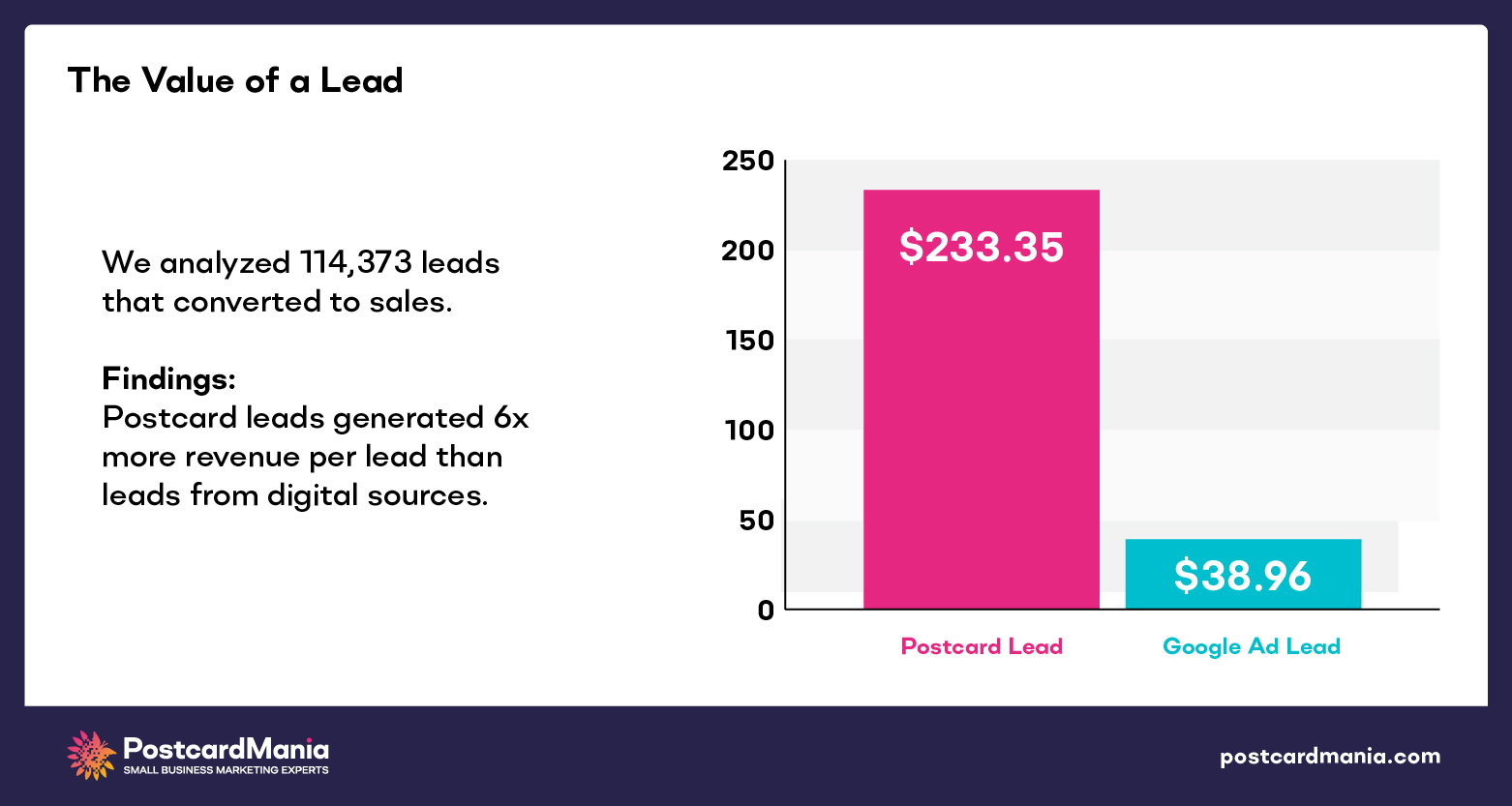
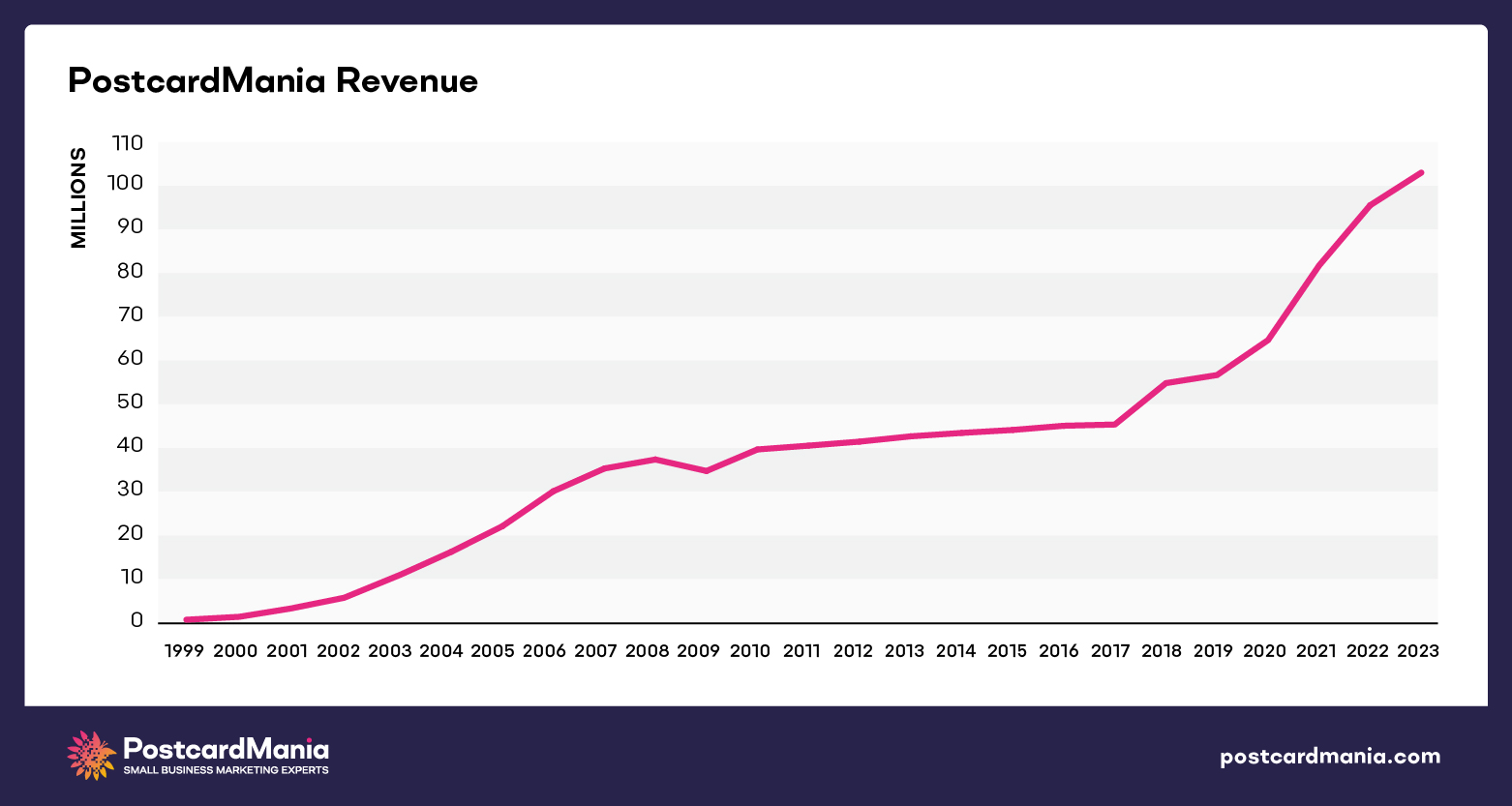
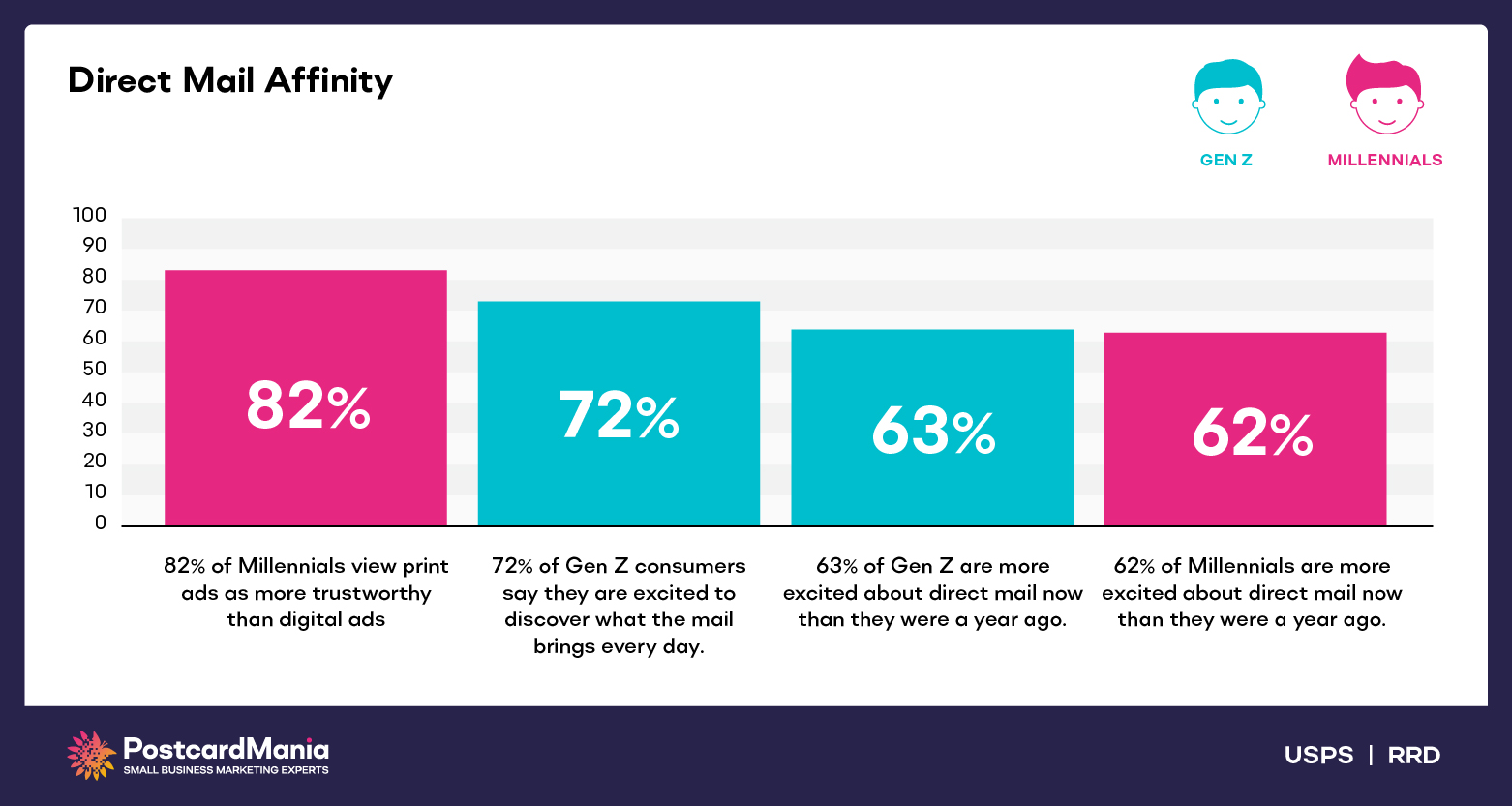
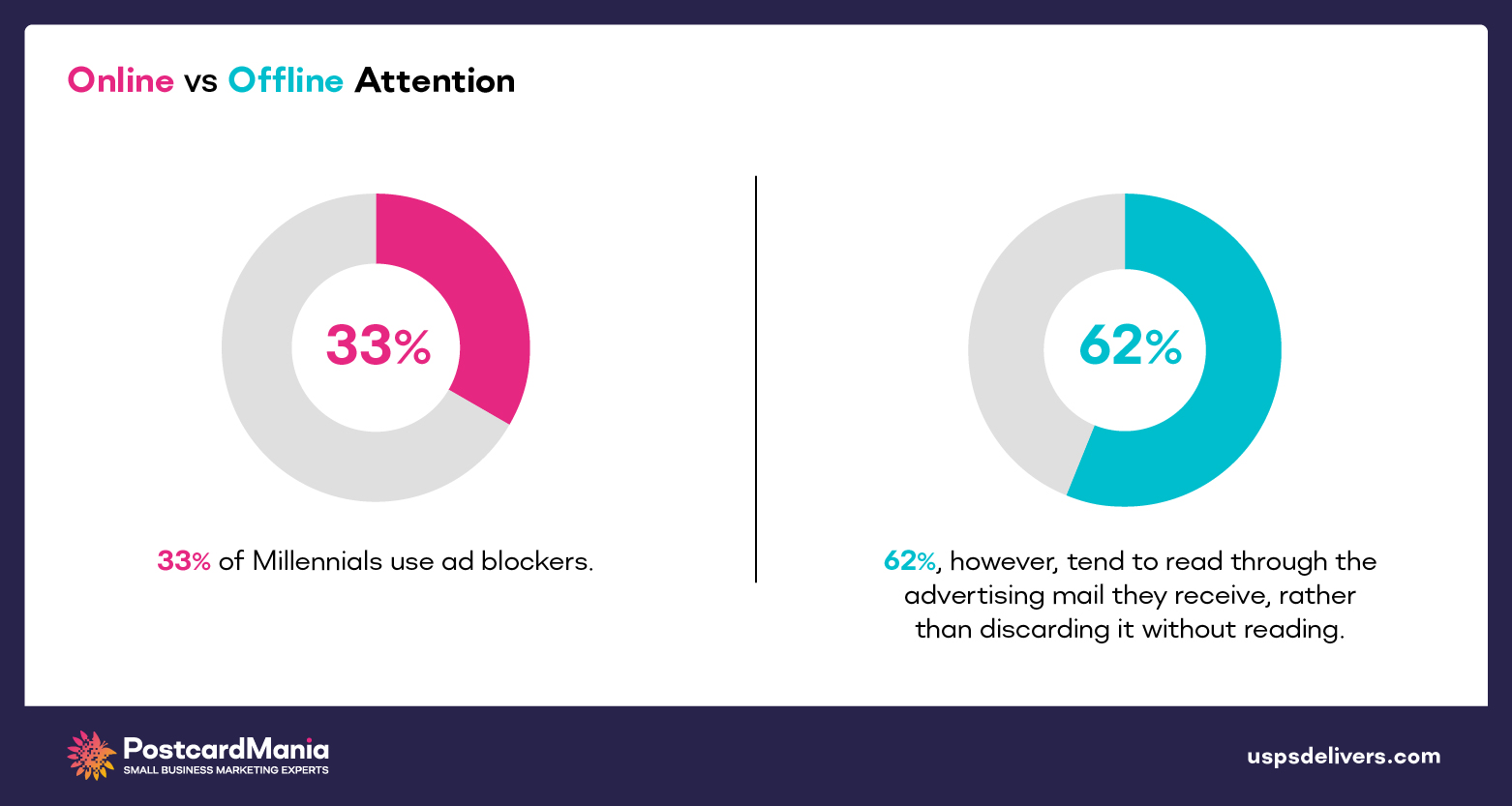
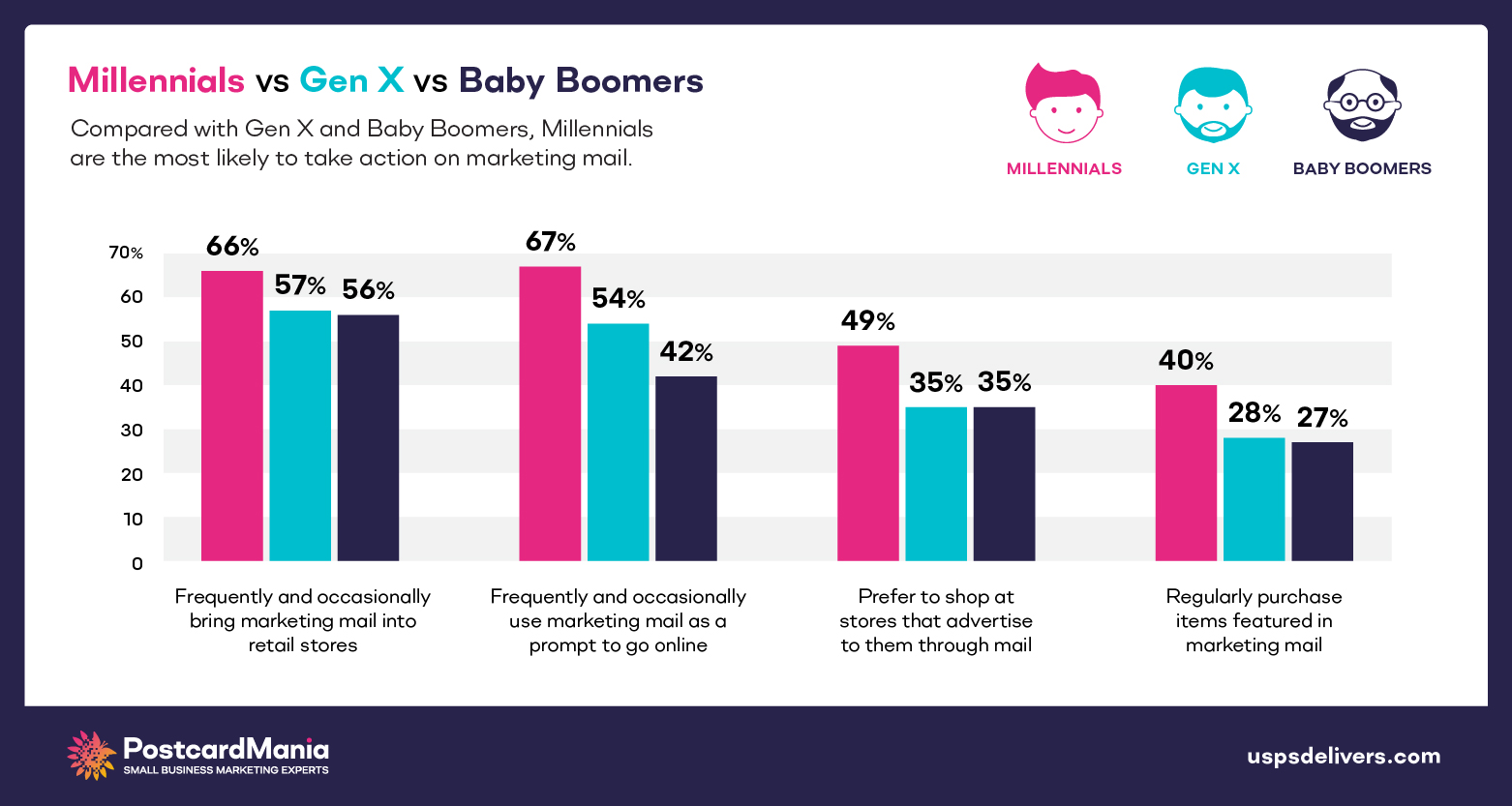
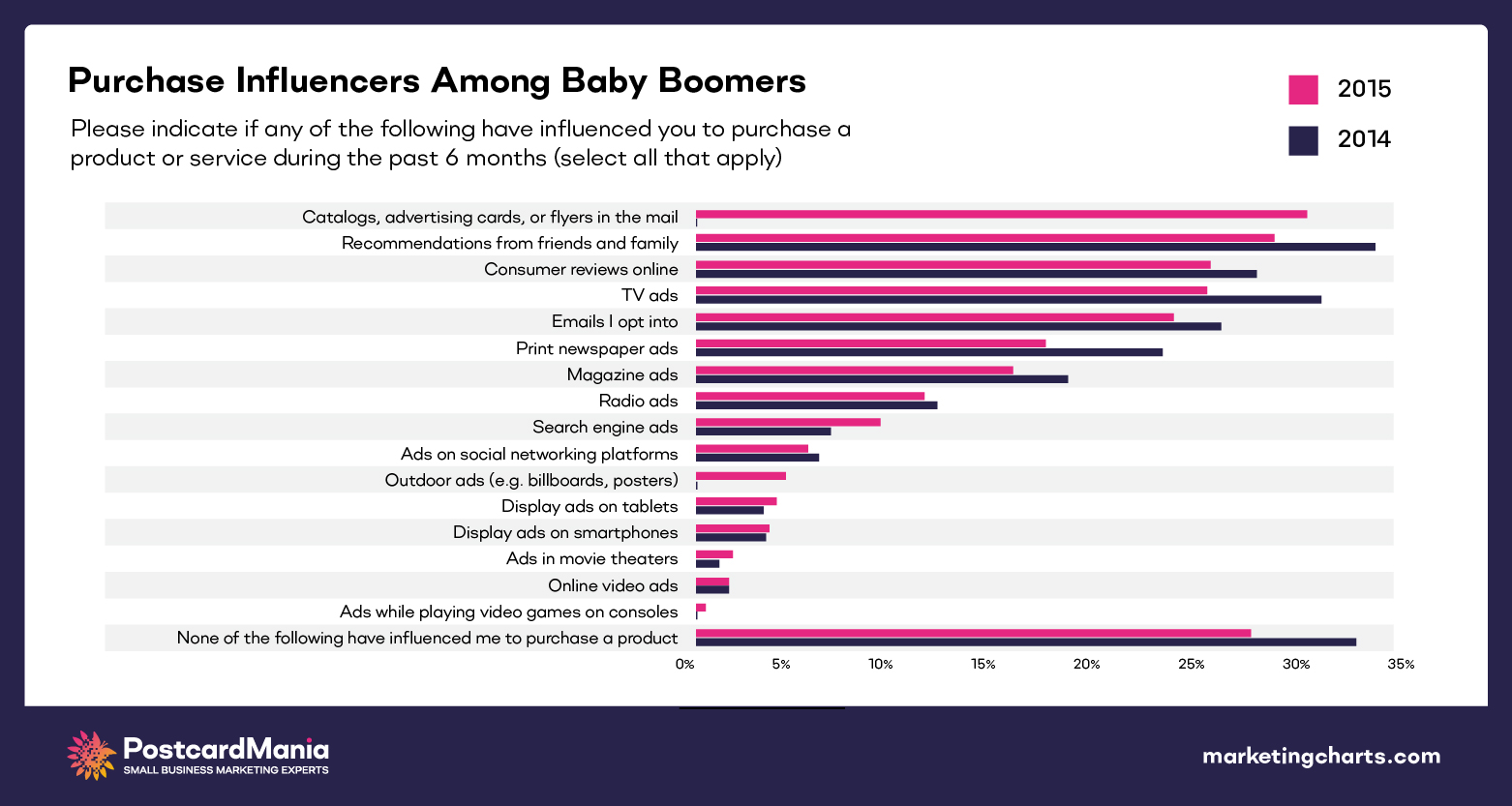
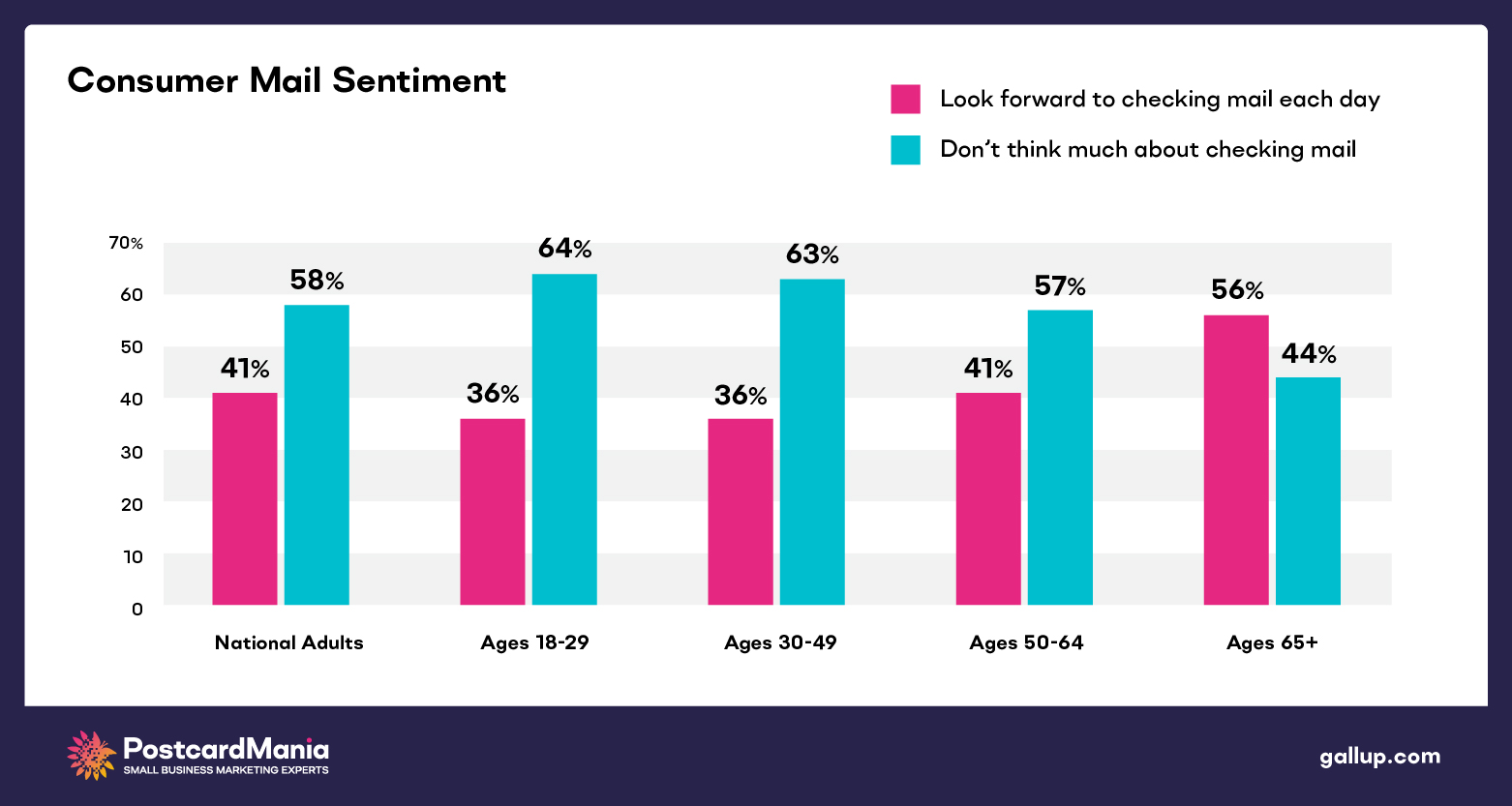
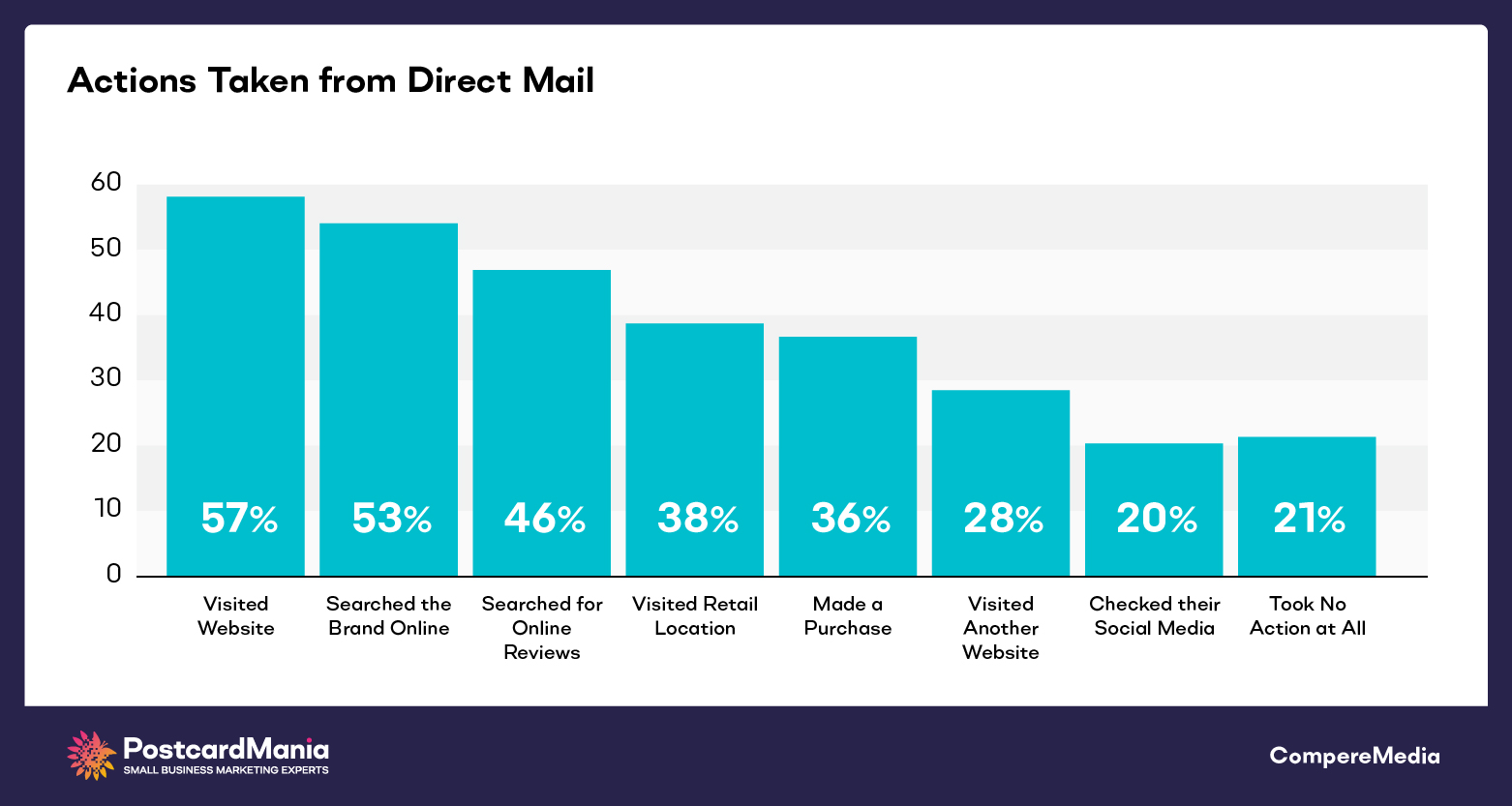
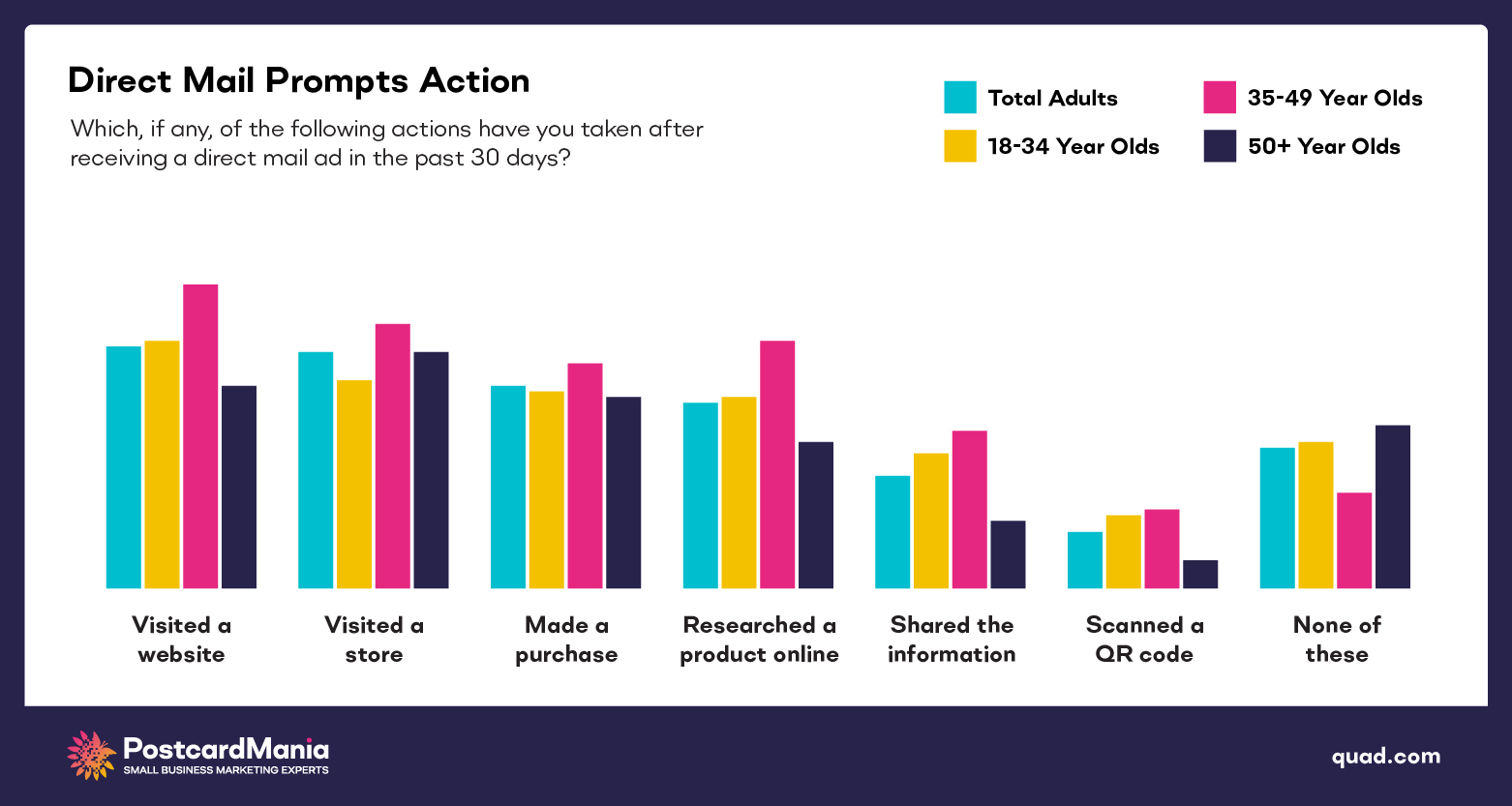
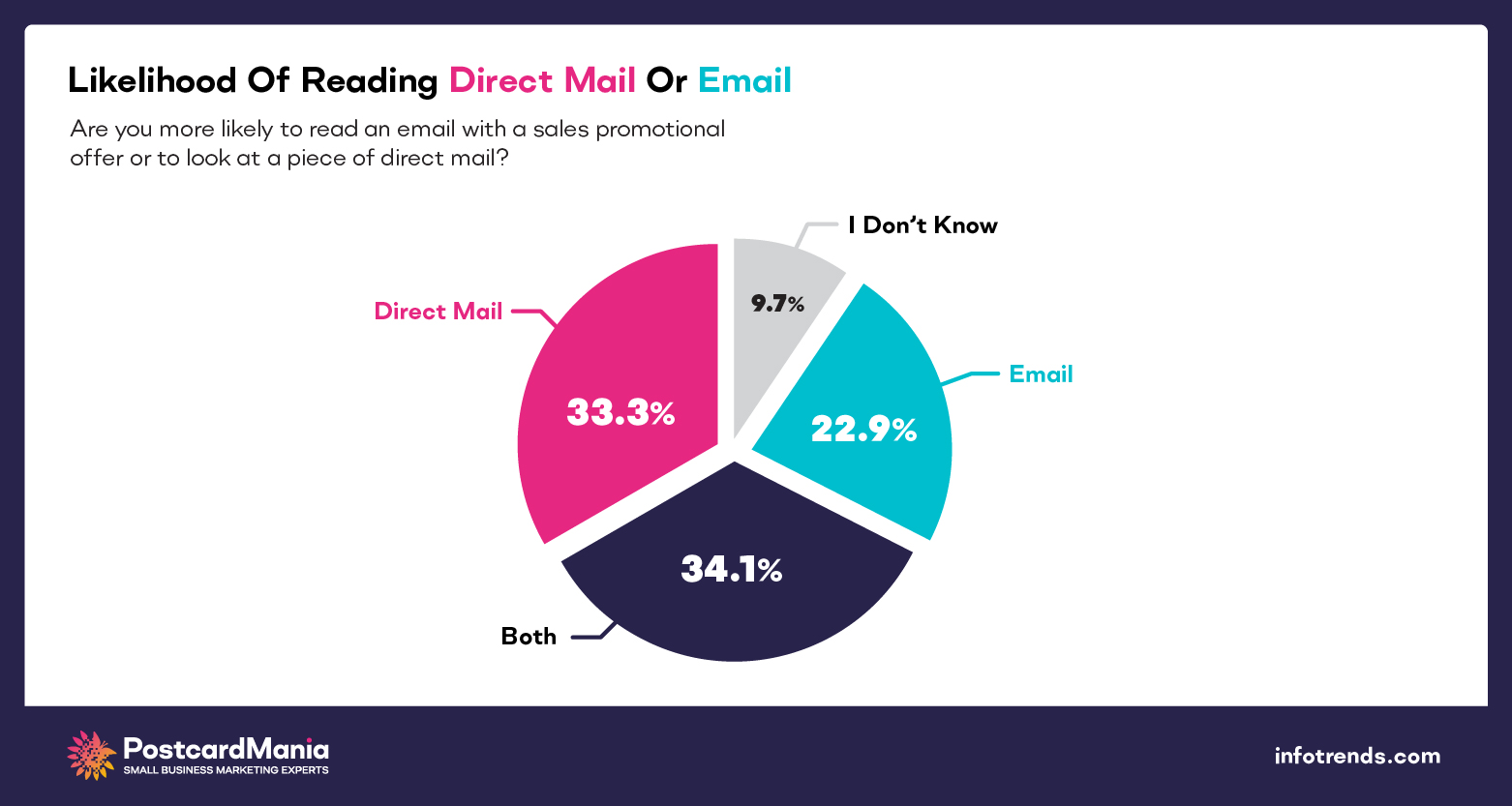 Direct mail’s average response rate increased from 2.9% to 4.9% for prospects lists and 5.1% to 9% for house lists (current customers/database) between 2017 and 2018.
Direct mail’s average response rate increased from 2.9% to 4.9% for prospects lists and 5.1% to 9% for house lists (current customers/database) between 2017 and 2018. 